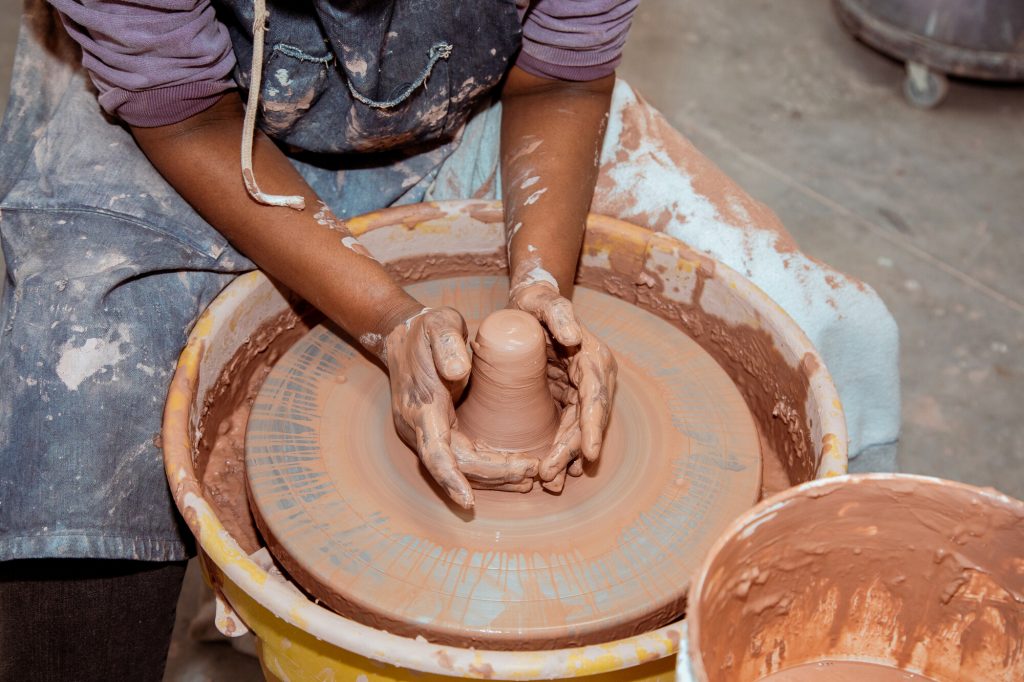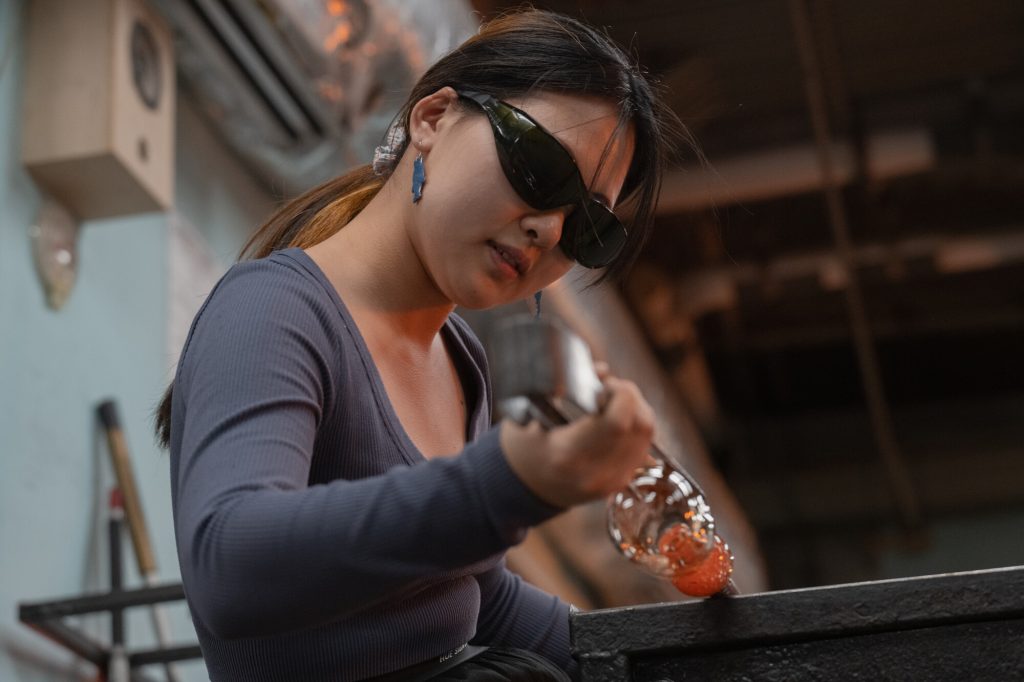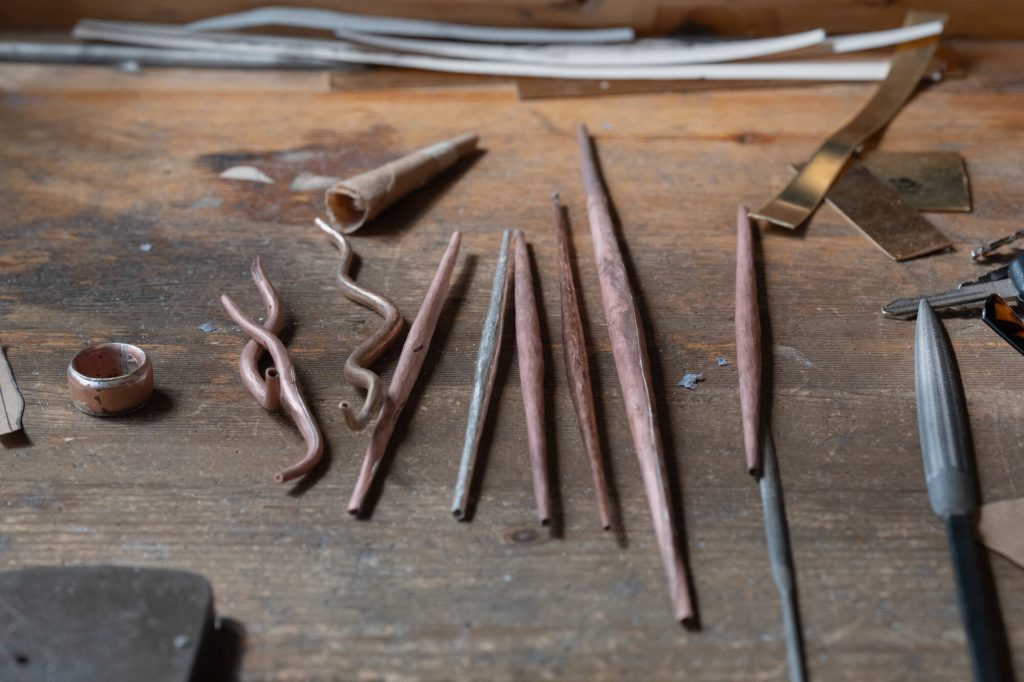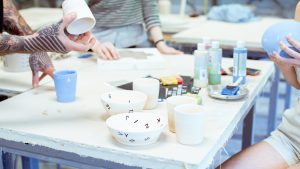Clay
 The Ceramics program is dedicated to the idea that a student’s future success is dependent on creative excellence, strong technical skills and a good basic liberal arts education.
The Ceramics program is dedicated to the idea that a student’s future success is dependent on creative excellence, strong technical skills and a good basic liberal arts education.
Courses are designed to enable students to build technical skills, to provide exposure to contemporary methods of working in clay, to develop critical thinking skills, and to encourage students to develop a personal direction in the medium.
Courses address contemporary issues and promote an atmosphere that is balanced between conceptual development and material exploration. Specific ceramics courses dedicated to wheel throwing and handbuilding are the foundation of the program. Special topics courses in glaze calculation, mold making, sculptural form, and vessels are also offered.
In addition to courses within the program, ceramics students are encouraged to investigate the breadth of offerings in the School of the Arts. The University offers an MFA in Fine Arts with a concentration in Ceramics; this program entails a minimum of two years of intensive studio work. Graduate students are expected to demonstrate a serious dedication to their work and to the development of mature ideas and forms of expression.
The University offers an MFA in Fine Arts with a concentration in Ceramics. The Ceramics MFA program entails a minimum of two years of intensive artistic research and production. Graduate students are expected to demonstrate persistent curiosity, the willingness to take risks, and a serious dedication to their work and to the development of mature ideas and forms of expression. We encourage a deep exploration of ideas through a variety of techniques and materials while emphasizing the realization of your individual goals. Applicants of considerable diversity, from vessel makers to mixed media installation artists, are encouraged to apply.
Students have access to a wide range of equipment that allows for creative exploration in many forms, media, and scale. The Ceramics department is a well equipped area that includes: 11 electric kilns and 2 gas car kilns that are 35 cu. ft and 60 cu. ft, a plaster room with state of the art ventilation, fully equipped handbuilding and wheel rooms, a large raw material inventory, 3 clay mixers (2 Soldner, 1 Bluebird), 2 slab rollers, 2 manual extruders, a slip-o-matics casting slip mixer, a spray booth, and a two tier ball mill.
The Clay program is small and select and expectations are high. Up to six ceramic graduate students work in their own private studios and also have access to a large communal project space that is only open to graduate students within the Ceramics Department. The work that is made each semester is presented in our gallery space where formal critiques with your faculty and peers from the entire Craft and Material Studies Department take place. Our diverse and accomplished faculty offer direction that encourages the graduate students to create work that challenges the notions of Contemporary Ceramics and the Art World beyond clay. Each semester you will meet with your selected faculty committee to present your work for candidacy review. Once candidacy is attained, the MFA processes concludes with your thesis exhibition.
The Ceramics program occupies 8000 sq. ft. in three large studios, a large kiln room, plaster room, glaze room, a glaze mixing room, and a clay mixing room, all with state-of-the-art ventilation and air handling equipment.
The Advanced and Graduate studio contains spaces for advanced students and six private spaces for graduate students. The handbuilding studio is equipped with:
- one 20″ slab roller
- one 36″ slab roller
- two manual extruders
- one pneumatic extruder
- eight large canvas-covered tables
- a low-fire glazing area
- and shelving space
The throwing studio is equipped with:
- 16 electric Shimpo Whisper wheels
- 3 large plaster wedging tables
- 14 canvas-covered tables
- scale
- and shelving area
The plaster room is equipped with:
- a state-of-the-art ventilation system for mixing
- a solid granite mold table
- mold drying racks
- and 1 casting slip mixer
The glaze room is set up for high-fire glazing and is equipped with a glaze table that holds shop glazes and shelving. The glaze-mixing room is equipped with:
- a spray booth
- a two-tier ball mill
- triple beam and digital scales
- and a ventilated mixing area
The clay mixing room is equipped with:
- 2 large Soldner mixers
- a Bluebird mixer
- dry mix tubs
- and ventilated mixing areas
The kiln room is equipped with 11 electric kilns:
- all of which are computer controlled
- 3 electric test kilns
- 35 cu. ft. and 60 cu. ft. Bailey gas car kilns with oxygen probes
Fiber
 The Fiber Program is dedicated to the idea that a student’s future success is dependent on creative excellence, strong technical skills and a good basic liberal arts education.
The Fiber Program is dedicated to the idea that a student’s future success is dependent on creative excellence, strong technical skills and a good basic liberal arts education.
Our courses are designed to allow each student to pursue a personal direction in their work that may be traditional or non-traditional, applied or non-applied. While emphasis is placed on ideation, courses promote an atmosphere conducive to material and technical exploration. Courses at all levels are designed to explore both basic issues and specialized topics. Specific surface design courses focus on pattern design, direct and resist dye techniques, screen printing and embellishment. Weaving courses focus on both image and pattern and cover tapestry, drafting, pattern weaving and related dye processes. Other course work includes feltmaking, embroidery, quilting, crochet and knitting.
Our well equipped studios are available to our students 24 hours a day. The textile studios and dye facility have beautiful natural light. The large, open studios encourage casual interaction between the students at all levels.
The University offers an MFA in Fine Arts with a concentration in Fiber. The MFA Fiber program entails two years of intensive studio work. Graduate students are expected to demonstrate a serious dedication to their work and to the development of mature ideas and forms of expression.
We encourage deep exploration of ideas, techniques and materials. Students may work in an inter-disciplinary manner or focus entirely on fiber. This is primarily a self directed program where students make the decisions about their direction of study. Each student meets regularity with a Faculty committee where lively critiques and conversations about the students work are the goal. An average week includes a Fiber graduate studio class, Graduate Seminar, Critique Class, studio hours and perhaps an Art History class. The Department has an active Visiting Artist Program and students are encouraged to take advantage of studio visits with our guest artists.
The Fiber program is small and select. Four students work in private or semi-private studios within the Fiber area. The students have access to a wide range of equipment, print tables, and a dye room.
The Fiber Program occupies two large studios, along with a complete dye facility, a darkroom for photo screen preparation and cleaning, and a graduate studio.
The Surface Design Studio is outfitted with two 5’x10′ and two 6’x10′ print tables and various other working surfaces. The Weaving Studio is equipped with 24 looms including a 16 harness AVL compu-dobby loom, 3 Shannock tapestry looms and a wide range of Macomber, Gillmore and Cranbrook looms, along with warp preparation equipment.
Glass
 Glass Studies provides an environment that promotes the growth and nurturing of young Artists, Designers, and Artisans. Students are challenged on a daily basis to apply themselves to the creation and completion of images/objects that identify and utilize the singularly unique qualities of the material glass.
Glass Studies provides an environment that promotes the growth and nurturing of young Artists, Designers, and Artisans. Students are challenged on a daily basis to apply themselves to the creation and completion of images/objects that identify and utilize the singularly unique qualities of the material glass.
A concentration in Glass in the BFA program involves committing a large block of time to the development of a clear personal vision, a sense of intention, and a basic facility in a wide range of material manipulation techniques. The Glass Program stresses excellence in the individual strengths of young Artists, Designers, and Crafts people. As a rule, we respect encourage the old adage of learning by doing, and more often than not, learning experientially through what could be categorized as failure!
The main philosophical thrust of the undergraduate area of study can be said to be, “never underestimate the value of editing!” Students are challenged to be prolific in their experiments and must learn to be their own harshest critics. Our highest goal is to encourage the development of an intellectual and emotional fearlessness in the individual’s investigation into the expressive range of material.
The MFA in Fine Art with a concentration in Glass program demands a minimum of two years of intensive studio work, during which time students are expected to demonstrate a serious dedication to their studio practice through steadfast perseverance, and a constant maintenance of their individual focus.
The students are (as a highest ideal) expected to identify aspects of the material that lead them to intellectually, and emotionally fearless art making. The visual vocabularies of all members of the graduate studies program in glass will be extensively supplemented through personally directed in depth research, across a wide swath of disciplines.
In the end each graduate course of concentrated study is individually developed, individually tailored, as well as self-driven, where within each student will work closely with a committee of professional faculty members, all of his or her choosing. The end point of study will be the presentation of a culminating solo masters exhibition that showcases the original research undertaken and completed over the two year period.
The Glass facilities consist of two large main classrooms housing workspace for kiln casting and lampworking facilities, a hot glass shop, cold working lab, and graduate studios.
The Glass Program is a 5000 sq ft facility that includes a Hot Shop equipped with:
- a 500 lb Spiral Arts tank furnace
- 28” x 40” large Spiral Arts glory hole
- 20” x 30” medium Spiral Arts glory hole
- pipe warmer and cooler garage
- 54” x 36” x 26” top loader
- 54” x 26” x 24” front loader
- four 26” x 20” x 16” front loaders
- one 4’ x 6’ x 2’ top loader
- GB4 controller
- and a color box
The Cold Shop is equipped with:
- a diamond lap wheel
- grit lap wheel
- diamond band saw
- 106” x 4” belt sander
- glass lathe with diamond and felt wheels
- and a 10” circular saw
The kiln room has two 36” x 30” x 12” Denver fusing kilns with West controllers, and two Paragon kilns (the largest being 44” x 22” x 16”)
There Lampworking studio equipped with 8 Carlisle CC burners and 5 Carlisle mini CC burners.
The Glass Program has five graduate studios each approximately 10.5’ x 8’.
Metal
 The Metal / Jewelry Program is dedicated to the idea that a student’s future success is dependent on creative excellence, strong technical skills and good basic liberal arts education.
The Metal / Jewelry Program is dedicated to the idea that a student’s future success is dependent on creative excellence, strong technical skills and good basic liberal arts education.
Courses are designed to allow each student the opportunity to pursue a personal direction in their work that may be traditional or non-traditional, applied or non-applied. While emphasis is placed on ideation, the courses promote an atmosphere conducive to material and technical exploration.
The beginning jewelry course focuses on the development of basic skills such as fabrication/soldering, cold connections, basic forming methods, bezel setting of cabochon stones, surface treatment and embellishment, and a variety of casting processes. Metalsmithing concentrates on metal-forming skills such as raising, seaming, and sinking as well as introducing additional technical information such as die forming, hinge making, basic enameling, lapidary and mold-making.
An MFA in Fine Arts with a concentration in the Metal program entails two years of intensive studio work. Graduate students are expected to demonstrate a serious dedication to their work and research as well as innovative forms of expression. The curriculum in metals focuses on curiosity, passion, and creativity.
Students must bring with them a strong foundation of working with metal. Ultimately, we want our students to experiment with both traditional and unorthodox approaches to making while exploring and discovering the rich history of the material. The Metals program is small and select. Up to four students work in a shared graduate studio within the Metals area. The students have access to a wide range of equipment with which to experiment and explore.
The Metals/Jewelry studio complex consists of ten rooms. The main bench room is adjacent to a machine room and a smithing studio. The machine room contains an area for welding (both MIG and acetylne), large machinery for cutting, grinding, and drilling and a sandblaster. The smithing studio has an extensive selection of stakes and hammers as well as a draw bench, milling machine, and machinist’s and watchmaker’s lathes.
There are separate rooms for annealing and acid handling, polishing, enameling and small-tool storage. The casting studio contains equipment for steam de-waxing, vacuum investing, burn-out kilns, and both vacuum and centrifugal casting. There is a separate studio for advanced level students who are assigned bench space. The graduate studios are discreet studio spaces adjacent to the main facility.
Wood
 The Studio Furniture/Wood Program champions individual voice supported by strong technical skills, critical thinking, and experimentation. Traditional woodworking techniques geared toward furniture design and construction as well as experimental processes are taught and encouraged.
The Studio Furniture/Wood Program champions individual voice supported by strong technical skills, critical thinking, and experimentation. Traditional woodworking techniques geared toward furniture design and construction as well as experimental processes are taught and encouraged.
Undergraduate classes are designed to give students a strong foundation in woodworking techniques while emphasizing idea development and experimentation. Lectures, demonstrations, and handouts, along with small class sizes that allow for one-on-one instruction, ensure that students learn to use the equipment safely.
Studio furniture, sculpture, and design are all supported in this program, and the Craft department’s emphasis on the five media, along with the nearby location of sculpture facilities, allows for the incorporation of other media such as cast and blown glass, clay, metal, and fiber. Material interplay is supported and encouraged!
The MFA in Fine Arts with a concentration in Wood program entails two years of intensive studio work. Graduate students will demonstrate a serious dedication to their work and to the development of their vision. Surrounded by the energy of a vibrant undergraduate program, a tight-knit cohort of interdisciplinary MFA candidates, and through meetings with the wood area faculty and other committee members you will be supported in your quest to establish yourself in this field.
The Studio Furniture/Wood Program occupies approximately 7000 sq.ft. and consists of a large bench room with a general class bench area plus 27 individual Ulmia benches.
The machine room includes:
- 2- 10” 5hp Saw stop table saws
- 24″ Powermatic bandsaw
- 24” Tannewitz bandsaw
- 14″ Oliver bandsaw
- 24″ Powermatic planer
- 12” Portable Dewalt Planer
- 16” Oliver Jointer
- 12″ Bridgewood Jointer
- 24” Grizzly Thickness Sander
- Rockwell Radial Arm Saw
- Multi Router
- Two One-Way lathes
- 56″ Crouch edge sander
- 20″ Jet disk sander
- Grizzly spindle sander
- Safety cut panel saw
- Downdraft table
- Router table
- Dewalt scroll saw
- Dewalt sliding miter saw
- Vacuum Bag 4’X8’ (and additional smaller bags)
- Steam bending equipment
- Festool Domino
- Festool Track Saw
- Tormek Sharpening System with carving tool attachments
- Wide assortment of hand tools-planes, gouges, chisels, files, etc
- Assortment of Wetzler, Bessey, and Jorgensen clamps
- Spray Booth




